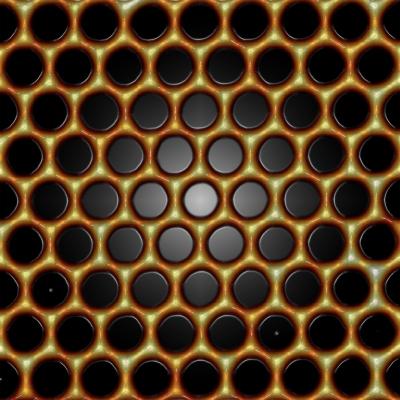Scientists from the Department of Energy's SLAC National Accelerator Laboratory in US and Stanford University have developed a system of "designer electrons". These are amazing variants of normal electrons having tunable properties from which novel devices and materials can be produced.
 Precisely positioned carbon monoxide molecules (black) guide electrons (yellow-orange) into a nearly perfect honeycomb pattern called molecular graphene. Electrons in this structure have graphene-like properties; for example, unlike ordinary electrons, they have no mass and travel as if they are moving at the speed of light in a vacuum. To make this structure, scientists from Stanford and SLAC National Accelerator Laboratory used a scanning tunneling microscope to move individual carbon monoxide molecules into a hexagonal pattern on a perfectly smooth copper surface. The carbon monoxide repels the free-flowing electrons on the copper surface, forcing them into a graphene-like honeycomb pattern. Credit: Manoharan Lab, Stanford/SLAC
Precisely positioned carbon monoxide molecules (black) guide electrons (yellow-orange) into a nearly perfect honeycomb pattern called molecular graphene. Electrons in this structure have graphene-like properties; for example, unlike ordinary electrons, they have no mass and travel as if they are moving at the speed of light in a vacuum. To make this structure, scientists from Stanford and SLAC National Accelerator Laboratory used a scanning tunneling microscope to move individual carbon monoxide molecules into a hexagonal pattern on a perfectly smooth copper surface. The carbon monoxide repels the free-flowing electrons on the copper surface, forcing them into a graphene-like honeycomb pattern. Credit: Manoharan Lab, Stanford/SLAC
The study was conducted by Hari Manoharan, an Associate Professor at Stanford’s Physics Department and SLAC's Stanford Institute for Materials and Energy Sciences member and his team.
The honeycomb-shaped structures were hand-crafted and made to a form similar to graphene. These structures were known as molecular graphene. Scanning tunneling microscope was used to produce these structures. A carbon monoxide molecule was placed on the smooth surface of copper. The free flowing electrons on the surface of copper are repelled by the carbon monoxide molecules which results in the formation of honeycomb pattern of electrons. The electron behavior resembled graphene electrons.
The carbon monoxide molecules were repositioned on the surface for tuning the properties of electrons which altered the electron flow symmetry. Some configuration of electrons behaved like they were under electric or magnetic field whereas in other patterns the scientists finely tuned the electron density by adding impurities or defects. The mass of the electrons were restored in selected tiny regions by the scientists through complex patterns imitating alterations in strength and C-C bond length of graphene.
Manoharan stated that the team made the electrons to think that they were under magnetic field even though it was not used. The research group followed the theory developed by the co-author of the paper Francisco Guinea from Spain. By applying the theory, they calculated the positions of carbon atoms in graphene to create the magnetic field like effect at a range of 0 – 60 T. Then carbon monoxide molecules were accurately moved to the calculated positions and the electrons reacted as if they were exposed to magnetic field, exactly as thought by researchers.
The study has been published in the journal Nature.